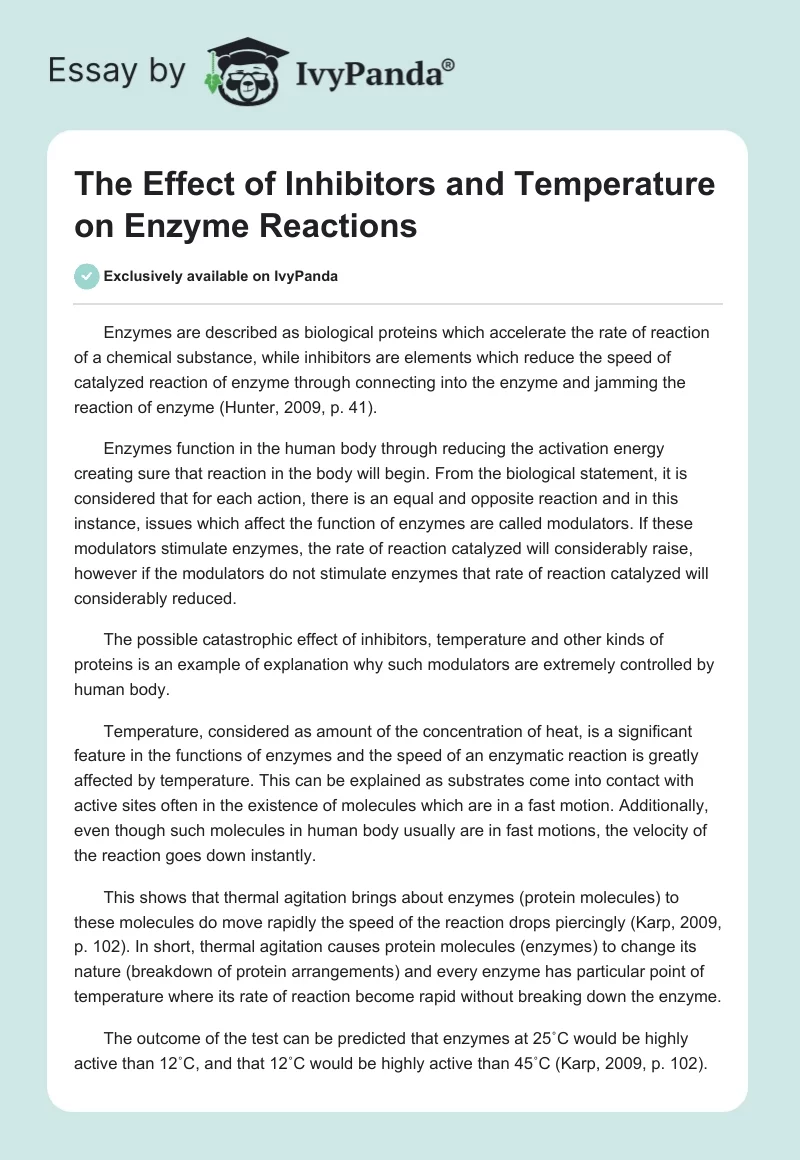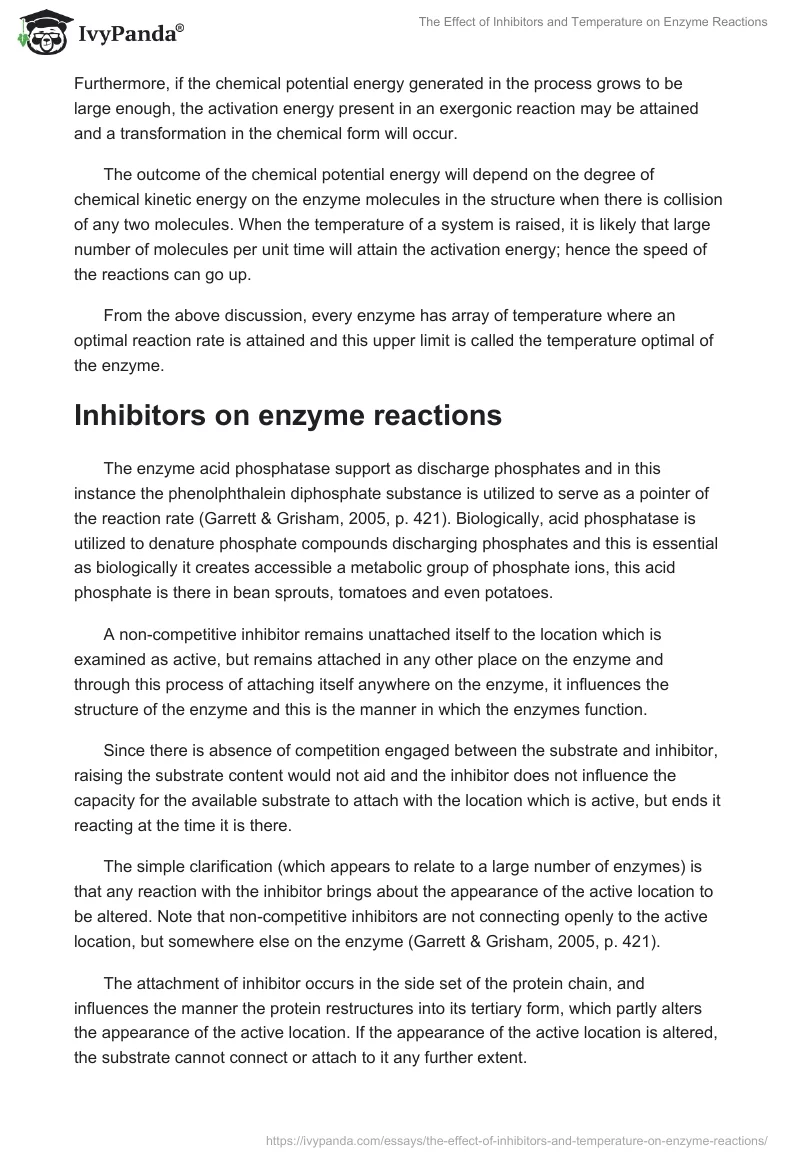Enzymes are described as biological proteins which accelerate the rate of reaction of a chemical substance, while inhibitors are elements which reduce the speed of catalyzed reaction of enzyme through connecting into the enzyme and jamming the reaction of enzyme (Hunter, 2009, p. 41).
Enzymes function in the human body through reducing the activation energy creating sure that reaction in the body will begin. From the biological statement, it is considered that for each action, there is an equal and opposite reaction and in this instance, issues which affect the function of enzymes are called modulators. If these modulators stimulate enzymes, the rate of reaction catalyzed will considerably raise, however if the modulators do not stimulate enzymes that rate of reaction catalyzed will considerably reduced.
The possible catastrophic effect of inhibitors, temperature and other kinds of proteins is an example of explanation why such modulators are extremely controlled by human body.
Temperature, considered as amount of the concentration of heat, is a significant feature in the functions of enzymes and the speed of an enzymatic reaction is greatly affected by temperature. This can be explained as substrates come into contact with active sites often in the existence of molecules which are in a fast motion. Additionally, even though such molecules in human body usually are in fast motions, the velocity of the reaction goes down instantly.
This shows that thermal agitation brings about enzymes (protein molecules) to these molecules do move rapidly the speed of the reaction drops piercingly (Karp, 2009, p. 102). In short, thermal agitation causes protein molecules (enzymes) to change its nature (breakdown of protein arrangements) and every enzyme has particular point of temperature where its rate of reaction become rapid without breaking down the enzyme.
The outcome of the test can be predicted that enzymes at 25˚C would be highly active than 12˚C, and that 12˚C would be highly active than 45˚C (Karp, 2009, p. 102). Furthermore, if the chemical potential energy generated in the process grows to be large enough, the activation energy present in an exergonic reaction may be attained and a transformation in the chemical form will occur.
The outcome of the chemical potential energy will depend on the degree of chemical kinetic energy on the enzyme molecules in the structure when there is collision of any two molecules. When the temperature of a system is raised, it is likely that large number of molecules per unit time will attain the activation energy; hence the speed of the reactions can go up.
From the above discussion, every enzyme has array of temperature where an optimal reaction rate is attained and this upper limit is called the temperature optimal of the enzyme.
Inhibitors on enzyme reactions
The enzyme acid phosphatase support as discharge phosphates and in this instance the phenolphthalein diphosphate substance is utilized to serve as a pointer of the reaction rate (Garrett & Grisham, 2005, p. 421). Biologically, acid phosphatase is utilized to denature phosphate compounds discharging phosphates and this is essential as biologically it creates accessible a metabolic group of phosphate ions, this acid phosphate is there in bean sprouts, tomatoes and even potatoes.
A non-competitive inhibitor remains unattached itself to the location which is examined as active, but remains attached in any other place on the enzyme and through this process of attaching itself anywhere on the enzyme, it influences the structure of the enzyme and this is the manner in which the enzymes function.
Since there is absence of competition engaged between the substrate and inhibitor, raising the substrate content would not aid and the inhibitor does not influence the capacity for the available substrate to attach with the location which is active, but ends it reacting at the time it is there.
The simple clarification (which appears to relate to a large number of enzymes) is that any reaction with the inhibitor brings about the appearance of the active location to be altered. Note that non-competitive inhibitors are not connecting openly to the active location, but somewhere else on the enzyme (Garrett & Grisham, 2005, p. 421).
The attachment of inhibitor occurs in the side set of the protein chain, and influences the manner the protein restructures into its tertiary form, which partly alters the appearance of the active location. If the appearance of the active location is altered, the substrate cannot connect or attach to it any further extent.
If, at any case, cysteine remains are anywhere on the chain of protein, which influences the manner it restructures its tertiary form, therefore changing this set can affect the appearance of the active location, and as a result end the enzyme from functioning.
In contradiction of other kinds of reversible inhibition, in which the impacts on the reaction of enzyme rely on the content of an inhibitor, there are several instances of compounds which react in chemical form with residues in the location of the active enzyme. In such examples, enzyme actions are wiped out, for instance the reaction between an active site Ser residue with “nerve gas” Sarin on the enzyme, which can be put as acetylcholinesterase (Russell, Hertz, & McMillan, 2011, p. 81).
In condition that acetlycholine may not be hydrolyzed by such enzyme, the indicators of the nerve may not be taken over the synapses of the structure of nerve. On any contact with such compound, it may cause death instantly because of respiratory problem.
Various non-competitive inhibitors connect permanently to the enzyme and as a result end it functioning enduringly, but some other types attach temporarily. The rationale of the analysis is to study the activity of enzymes when there is fluctuation, raise or reduced, temperature.
Hypothesis
The hypothesis which is related to temperature is that at 25°C the catecholase will show the most output. While the hypothesis for inhibitors is that there is no impact of changing the quantity of inhibitor applied and also the transmission percentage will stay steady for every solution regardless of changing concentration of inhibitor.
Another hypothesis is that while the concentration of sodium dihydrogen phosphate is raised the speed of reactions will reduce and this will be shown by reduce in percentage transmission as there is reduced concentration of inhibitor.
Methods and Materials
The effects of temperature would be investigated and three test tubes would have 3 ml of pH 7 phosphate buffer put in and one test tube would be put in ice with temperature of 10°C.
Another test tube would be put in a test tube holder at a temperature of 25°C and the last test tube would be put in a beaker which is set to heated water. A test tube which has the potato fluid was placed in the heated water in the beaker and as well a test tube which has Catechol would be put in the temperatures below 0°C and one test tube in the heated water in the beaker.
After 15 minutes, 12 drops of Catechol would be put into every test tube of buffer in the experiment in line to the temperature. After that, 12 drops of potato fluid would be put into every test tube of buffer in the experiment as well corresponding temperatures and finally the tubes would be permitted to stay for six minutes for mixing. The outcome will be recorded according to their concentration.
References
Garrett, R., & Grisham, C. (2005). Biochemistry. New York: Cengage Learning.
Hunter, M. (2009). Effects of Temperature on Enzyme Kinetics. Boston: Ardent Media.
Karp, G. (2009). Cell and Molecular Biology: Concepts and Experiments. London: John Wiley and Sons.
Russell, P., Hertz, P., & McMillan, B. (2011). Biology: The Dynamic Science. Carlifornia: Cengage Learning.


